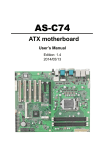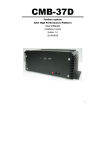Download MSI MS-6365 Motherboard
Transcript
INTRODUCTION Introduction The MS-6365 ATX mainboard is a high-performance computer mainboard based on Apollo Pro266 chipset. The MS-6365 is designed for the Intel® CeleronTM Pentium® II/III or Coppermine (FC-PGA) & VIA Cyrix III processor for inexpensive business/personal desktop markets. The Apollo Pro266 chipset consists of the VT8633 V-Link/DDR Host system controller and the VT8233 highly integrated V-Link/Client PCI/LPC controller. The VT8633 provides superior performance between the CPU, DRAM, AGP bus and V-Link interface with pipelined, burst, and concurrent operation and supports eight banks of SDR/DDR SDRAMs up to 4 GB and full AGP v2.0 capability including 2x and 4x mode transfers, SBA (SideBand Addressing), Flush/Fence commands, and pipelined grants. The VIA® VT8233 South Bridge enhances the functionality of the standard ISA peripherals and supports delayed transactions and remote power management so that slower ISA peripherals do not block the traffic of the PCI bus. In addition, the VT8233 includes eight levels (doublewords) of line buffers from the PCI bus to the ISA bus to further enhance overall system performance. This chapter contains the following topics: Mainboard Specifications Mainboard Layout Key Features MSI Special Features 1-1 1-2 1-4 1-5 1-6 CHAPTER 1 Mainboard Specification CPU ! Support Socket 370 for Intel® Celeron/ Pentium®II/III(FC-PGA) processor or VIA Cyrix III/Samuel processor ! Support 433MHz, 466MHz, 500MHz, 533MHz, 566MHz, 600MHz, 733MHz, 850MHz, 866MHZ, 933MHz, 1GHz or higher Chipset ! VIA® VT8633 chipset (552 BGA) - support 66/100/133 FSB - AGP 4x and Vlink plus Advanced Memory Controller - Support PC200/266 DDR technology ! VIA® VT8233 chipset (376 BGA) - High Bandwidth Vlink Client controller - Integrated Faster Ethernet LPC - Integrated Hardware Sound Blaster/Direct Sound AC97 audio - Ultra DMA 33/66/100 master mode PCI EIDE controller - ACPI Clock Generator ! 66.6MHz, 100MHz and 133MHz clocks are supported. Main Memory ! Support six memory banks using three 184-pin DDR DIMM. ! Support a maximum memory size of 3GB. Slots ! One AGP (Accelerated Graphics Port) PRO slot. - AGP v2.0 specification compliant ! One CNR (Communication Network Riser) slot. ! Six 32-bit Master PCI Bus slots. ! Supports 3.3V/5V PCI bus Interface. 1-2 INTRODUCTION On-BoardIDE ! An IDE controller on the VIA® VT8233 Chipset provides IDE HDD/CDROM with PIO, Bus Master and Ultra DMA 33/66/100 operation modes. ! Can connect up to four IDE devices. On-Board Peripherals ! On-Board Peripherals include: - 1 floppy port supports 2 FDD with 360K, 720K, 1.2M, 1.44M and 2.88Mbytes. - 2 serial ports (COMA + COMB) - 1 parallel port supports SPP/EPP/ECP mode - 6 USB ports (2 rear connector and 2 USB front pin header-4 USB ports) - 1 IrDA connector for SIR/CIR/ASKIR - 1 Audio/Game Port Audio ! Chip integrated BIOS ! The mainboard BIOS provides Plug & Play BIOS which detects the peripheral devices and expansion cards of the board automatically. ! The mainboard provides a Desktop Management Interface (DMI) function which records your mainboard specifications. Dimension ! ATX Form Factor Mounting ! 6 mounting holes. 1-3 CHAPTER 1 Mainboard Layout Top: mouse Bottom: keyboard ATX Power Supply JVKB1 USB Top: Port 1 Bottom: Port 2 PSFAN JVUSB1 Socket 370 CPUFAN JCD1 JAUX1 JHM2 AC 97 Codec JATX12 JHM1 JPHON1 W83627HF-AW Top: Midi/ Game Port Bottom: Audio Port FDD1 VIA VT8633 chipset Diagnostic LED IR AGP Slot USB2 USB PC to PC Controller PCI SLOT 1 SW2 PCI SLOT 2 SW1 VT823 PCI SLOT 3 J1394A J1394B 1394 PH Controller SYSFAN IDE2 IDE1 PCI SLOT 5 BIOS PCI SLOT 6 JWOL1 CNR1 USB3 JGS1 PCI SLOT 4 1394 Link Layer Controller DIMM 3 Bottom: COMA\ COM B DIMM 2 DIMM 1 Top: LPT BATT JFP1 JAUDIO JMDM1 JBAT1 MS-6365 ATX Mainboard 1-4 JGL1 JRMS1 INTRODUCTION Key Features ! ! ! ! PC99 Color Connector ATX Form Factor Support Accelerated Graphic Port (AGP) Pro Add-In Card Support Intel® Pentium III(FC-PGA) processors or VIA Cyrix III/Samuel processor at 100MHz and 133MHz System Bus Frequencies ! ! ! ! ! ! ! ! ! PC AlertTM III (System Hardware Monitor) TCAV (Build-in Trend Micro Anti-Virus Protection on BIOS) Support DMI (Desktop Management Interface) through BIOS LAN Wake Up Function Modem (Internal/External) Ring Wake Up Function Support Ultra DMA/ATA33/66/100 CNR (Communication Network Riser) TI® 1394 support up to 400Mbps (option) USB PC to PC Function (option) 1-5 CHAPTER 1 MSI Special Features The following MSI special features are designed by MSI R&D which are features only in MSI mainboards. The MS-6365 mainboard is equipped with PC AlertTM III, TOP Tech.TM III and D-LEDTM. T.O.P TechIII The T.O.P TechTM is a extended sensing device that can 100% accurately detect the CPUs temperature. You can see the temperature on BIOS setup menu. The PC AlertTM also can provide the information. CPU temperature on Setup menu CMOS Setup Utility - Copyright(C) 1984-2000 Award Software PC Health Status Current CPU Temp. Item Help Current System Temp. Menu Level Current CPUFAN Speed > Current SYSFAN Speed Vcore 2.5V 3.3V 5V 12V ↑ ↓ → ← Move Enter:Select +/-/PU/PD:Value F10:Save ESC:Exit F1:General Help F5:Previous Values F6:Fail-safe defaults F7:Optimized Defaults 1-6 INTRODUCTION PC Alert III The PC AlertTM III is a utility you can find in the CD-ROM. The utility is just like your PC doctor that can detect the following PC hardware status during real time operation: * monitor CPU & system temperature * monitor fan speed * monitor system voltage * monitor chassis intrusion If one of the items above is abnormal, the program main screen will be immediately shown on the screen, with the abnormal item highlighted in red. This will continue to be shown until user disables warning. 1-7 CHAPTER 1 Features: ! Network Management - Monitoring & remote control ! Basic System Utilities - Scandisk & Defragment to maintain your HDD ! 3D Graphics Design - Enables a more friendly user interface ! Software Utilities - SoftCooler Optimized Cooling - Doctor Y2K diagnoses Y2K problems - BusRacing function adjusts F.S.B under Windows 95/98 - MoSpeed speeds up your modem transmission 1-8 INTRODUCTION D-LED The D-LED uses graphic signal display to help users understand their system. Four LEDs embedded in the mainboard provide up to 16 combinations of signals to debug the system. The 4 LEDs can debug all problems that fail the system, such as VGA, RAM or other failures. This special feature is very useful for the overclocking users. These users can use the feature to detect if there are any problems or failures. 4 3 2 1 Red Green Diagnostic LED D-LED !" Description System Power ON - The D-LED will hang here if the processor is damaged or not installed properly. Early Chipset Initialization Memory Detection Test - Testing onboard memory size. The D-LED will hang if the memory module is damaged or not installed properly. Decompressing BIOS image to RAM for fast booting. Initializing Keyboard Controller. Testing VGA BIOS - This will start writing VGA sign-on message to the screen. 1-9 CHAPTER 1 Processor Initialization - This will show information regarding the processor (like brand name, system bus, etc ) Testing RTC (Real Time Clock) Initializing Video Interface - This will start detecting CPU clock, checking type of video onboard. Then, detect and initialize the video adapter. BIOS Sign On - This will start showing information about logo, processor brand name, etc . Testing Base and Extended Memory - Testing base memory from 240K to 640K and extended memory above 1MB using various patterns. Assign Resources to all ISA. Initializing Hard Drive Controller Initializing Floppy Drive Controller Boot Attempt Operating System Booting - This will initialize IDE drive and controller. - This will initializing Floppy Drive and controller. - This will set low stack and boot via INT 19h. 1-10































